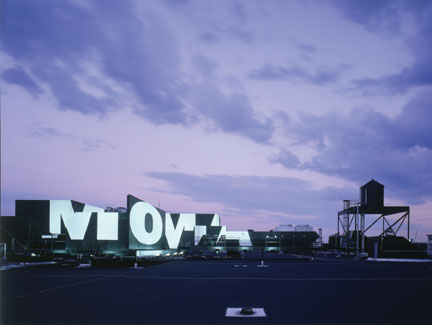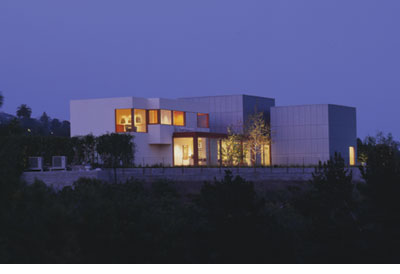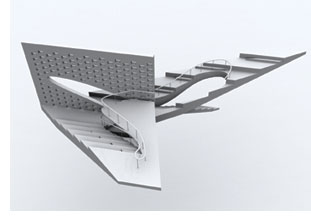Appreciating Architecture Through Alternate Ground
By Raymund Ryan, curator, Heinz Architectural
Center, Carnegie Museum of Art
Michael Maltzan,
the subject of a new exhibition on view in Carnegie Museum
of Art’s Heinz Architectural Center, is making a difference
with his designs for institutions and cities in the United
States and abroad.
One of several roles of the Heinz Architectural Center
is to present the work of emerging architects—local,
national, and international—to a Pittsburgh audience.
Unlike some contemporaries, Michael Maltzan not only proposes
provocative and sensuous new building forms, he is also
busy with the processes of construction. Based in Los Angeles,
Maltzan and his colleagues are out there on building sites
making a difference in the future of our institutions and
cities.
Michael Maltzan: Alternate Ground, currently on
view in the Heinz Architectural Center through June 12,
is the first complete exhibition dedicated to Michael Maltzan
Architecture. It comes at a time when Maltzan, having acquired
a remarkable reputation since establishing his firm in
1995, is beginning to acquire commissions and win competitions
abroad.

Malztan made his mark nationally with
his design of MoMA’s temporary home in Queens.
photo: Christian Richters
Two of Maltzan’s best-known projects, which are among
12 detailed models presented in the exhibition, are the
Hergott/Shepard Residence in Beverly Hills and MoMA QNS,
the Museum of Modern Art’s temporary facility in a
disused factory on Long Island. The Hergott/Shepard Residence,
which was included in The Un-Private House exhibition
at New York’s Museum of Modern Art in 1999, is a beautifully
crafted sequence of spaces from an understated front entrance
through high, carefully lit volumes out to a spectacular
panorama of Los Angeles far below. One of the strengths
of Maltzan’s design for the residence is the fact
that it does not overpower the clients’ impressive
collection of art, which is large and likely to change over
time.
Following Maltzan’s successes with the Hergott/Shepard
Residence and MoMA QNS, he has become known as an architect
especially sensitive to issues of how to accommodate art,
whether in private homes or in public museums. This is,
in part, why he appeared an ideal choice for architect of
the 2004–5 Carnegie International, on view
at Carnegie Museum of Art through March 20. In the International,
Maltzan’s work is most evident in the design of the
pedestals and cases for the work of Mangelos, Kathy Butterly,
and Robert Crumb. Many of his other interventions are necessarily
discreet and almost invisible.

The Hergott/Shepard Residence in Beverly
Hills, Ca., designed by Michael Maltzan Architecture, was
included in The Un-Private House exhibition at
New York’s Museum of Modern art in 1999. Photo:
Richard Barnes
Maltzan’s affinity with art and the needs of museums
has led to commissions for the UCLA Hammer Museum in Westwood,
Los Angeles, and radical new structures for the Fresno Metropolitan
Museum and the Sonoma County Museum further north in California.
In the case of the UCLA Hammer Museum, as the existing building’s
problems could not be resolved using orthodox architectural
tactics, Maltzan cleverly assembled an interdisciplinary
team of graphic, landscape, and lighting designers to direct
the renovation.
The title of the Heinz Architectural Center exhibition
is Alternate Ground because Maltzan is particularly
concerned with the way architecture both digs into and extends
above the earth’s surface. An animation in the exhibition
consisting of drawings of 12 key projects that dissolve
one into the next sets up this idea of “ground.”
Both the Fresno and Sonoma projects illustrate this
evolving theme in Maltzan’s work. The new architecture
incorporates some existing buildings, making them elements
in a complex assemblage without in any way mimicking or
replicating them. At the same time, Maltzan’s architecture
typically descends and ascends, via exposed stairs or—better
yet—ramped, floors to instigate a complex, pleasurable
promenade through the new interiors.
 The
Jinhua model is one of many that will be featured in the
exhibition. The
Jinhua model is one of many that will be featured in the
exhibition.
Some Modernist architects tried similar moves several decades
ago. However, Maltzan has absorbed the lessons of recent
urban theory (he graduated from Harvard’s Graduate
School of Design in 1987) and Postmodernism (he worked for
Frank Gehry, LA’s most famous architect, from 1988
to 1995). His work is about the human experience of buildings.
One immediately senses this from the open spaces he creates
between buildings—especially useful, of course, in
sunny California—and in the interiors where visitors
tend to be drawn onward by shifting views and the clever
manipulation of natural light.
One of the challenges for the Heinz Architectural Center
is to present architecture—typically buildings of
stone, concrete, and steel, sometimes situated thousands
of miles away or no longer in existence—to visitors,
many of whom might be unfamiliar with architectural drawings
and other modes of presentation. Michael Maltzan: Alternate
Ground will alleviate such impediments to enjoyment
and understanding of the work, as it is almost entirely
an exhibition of models.
A series of almost 200 models documents the processes through
which Maltzan and his team of architects studied issues
of shape, material, and the adjacency of component parts.
Thus, visitors are able to trace the evolution of particular
aspects of projects. Collectively these fragments of various
projects begin to suggest an urban landscape.
In addition to Maltzan’s key projects in the United
States, the exhibition includes three from abroad—in
Canada, China, and Milan—proof indeed that Maltzan
is an architect succeeding in today’s global arena.
A full-color catalogue has been produced for the exhibition.
Marking the internationalization of Maltzan’s career,
the book includes texts by acclaimed artist Ai Weiwei (Beijing)
and writer and urbanist Mirko Zardini (Milan), as well as
full accounts of the 16 projects on view.
Back | Top |